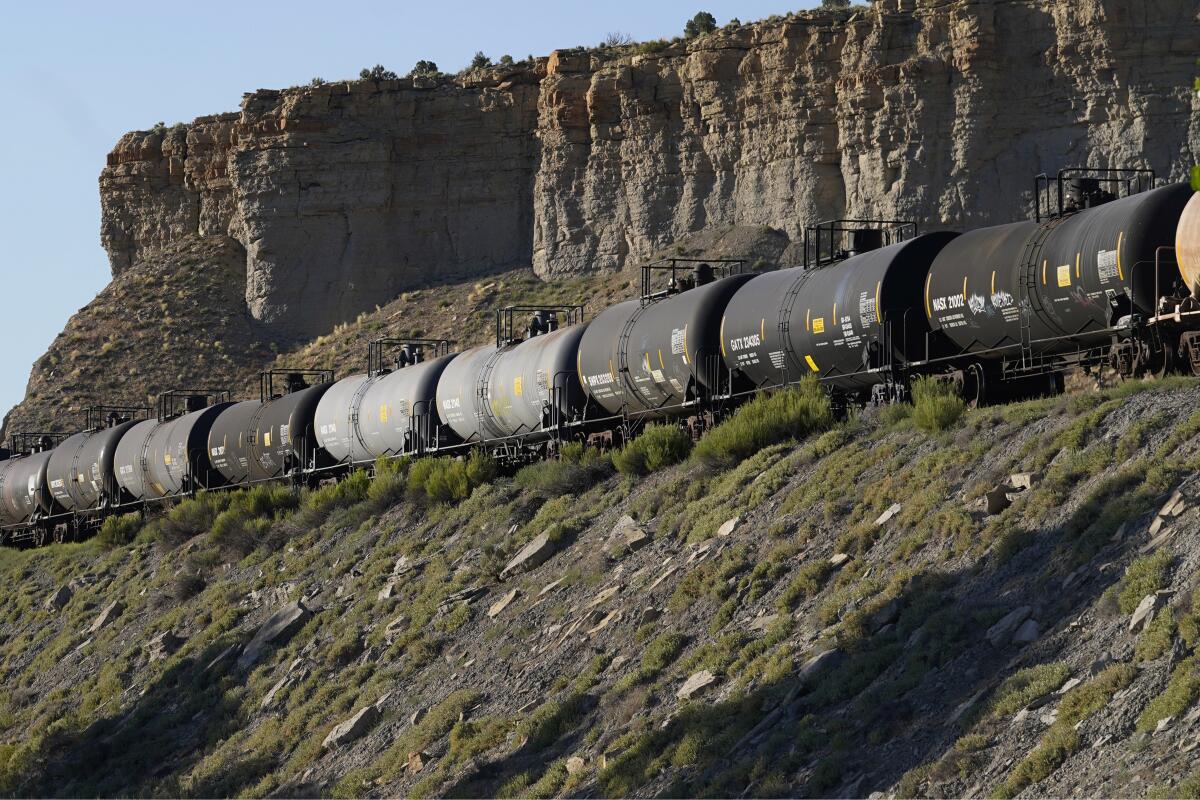Supreme Court sharply limits environmental impact statements in victory for developers

- Share via
- The justices said claims of the potential impact on the environment have been used too often to delay or block new projects.
- The high court ruled for the developers of a proposed 88-mile railroad in northeastern Utah that could carry crude oil that would be refined along the Gulf Coast.
WASHINGTON — The Supreme Court on Thursday sharply limited the reach of environmental impact statements in a victory for developers.
In an 8-0 decision, the justices said these claims of the potential impact on the environment have been used too often to delay or block new projects.
“A 1970 legislative acorn has grown over the years into a judicial oak that has hindered infrastructure development under the guise of just a little more process. A course correction of sorts is appropriate,” said Justice Brett M. Kavanaugh, speaking for the court.
He said judges and environmentalists have been given too much authority to hinder development.
“Fewer projects make it to the finish line. Indeed, fewer projects make it to the starting line. Those that survive often end up costing much more than is anticipated or necessary,” he said.
“And that in turn means fewer and more expensive railroads, airports, wind turbines, transmission lines, dams, housing developments, highways, bridges, subways, stadiums, arenas, data centers, and the like. And that also means fewer jobs, as new projects become difficult to finance and build in a timely fashion,” Kavanaugh added.
The Trump administration says it isn’t connected to Project 2025. But the administration has already accomplished about 70% of Project 2025’s environment-related recommendations.
The decision could loom large in California and the West because the U.S. 9th Circuit Court of Appeals has taken a broad view of environmental protection and the scope of impact statements.
“Today’s decision undermines decades of legal precedent that told federal agencies to look before they leap when approving projects that could harm communities and the environment,” said Earthjustice Vice President Sam Sankar. “The Trump administration will treat this decision as an invitation to ignore environmental concerns as it tries to promote fossil fuels, kill off renewable energy, and destroy sensible pollution regulations.”
Wendy Park, a senior attorney at the Center for Biological Diversity, described the court’s ruling as a “disastrous decision” that will undermine the nation’s bedrock environmental laws, ultimately resulting in more pollution and greater threats to public health.
“It guarantees that bureaucrats can put their heads in the sand and ignore the harm federal projects will cause to ecosystems, wildlife, and the climate,” Park said in a statement.
But Dan Wolff, an administrative law attorney with the D.C.-based firm Crowell & Moring, said he believes the Supreme Court’s decision is a reasonable interpretation of the National Environmental Policy Act of 1970, or NEPA, and exercise of the court’s authority.
Over the decades, NEPA has ballooned from a straightforward reporting process into a lengthy rabbit hole of bureaucracy, he said. The court’s decision is intended to remind lower courts that that’s not what NEPA provides for.
The American Petroleum Institute welcomed the ruling.
“Today, the Supreme Court took long overdue steps to restore NEPA to its original intent and ensure a broken permitting process doesn’t stand in the way of American oil and natural gas production,” said its general counsel, Ryan Meyers. “This unanimous ruling underscores how NEPA has been weaponized by activists to block U.S. infrastructure of all kinds at the expense of American workers and consumers.”
The decision could have ramifications for major projects in California, including the high-speed rail — the largest public infrastructure project in the country — that will connect San Francisco to Anaheim. The majority of the project’s first phase has already cleared state and federal environmental review, according to the High-Speed Rail Authority.
But its last segment, which will link Los Angeles to Anaheim, has yet to undergo NEPA or the state’s equivalent known as the California Environmental Quality Act, or CEQA. Phase 2 of the project, which is still many years away but would eventually extend the system to connect Merced to Sacramento and Los Angeles to San Diego, also has yet to undergo the reviews.
Agency officials said they haven’t yet had a chance to study the Supreme Court’s decision, and so it is unclear what the ruling’s effect will be, if any.
The same is true for the Delta Conveyance Project — a proposed $20-billion tunnel that would move water from the Sacramento-San Joaquin River Delta to cities and farmlands to the south that is undergoing NEPA review. Opponents of the controversial project have vowed to block the tunnel over concerns that it would harm the environment, fish species and local communities.
NEPA was the first of a series of landmark environmental laws. It required federal agencies to prepare a report assessing the likely impact of projects that will be funded or approved by the government.
NEPA has roots in California, where a 1969 oil spill off the coast helped spark the modern environmental movement. The spill, which occurred as Congress was drafting NEPA regulations, generated significant public outrage and helped galvanize national support for federal environmental protection laws.
But Kavanaugh said the “purely procedure law” of 1970 has been turned into “a substantive roadblock. ... The goal of the law is to inform agency decisionmaking, not to paralyze it.”
In Thursday’s unanimous decision, the high court ruled for the developers of a proposed 88-mile railroad in northeastern Utah, a spur line that could carry crude oil that would be refined along the Gulf Coast.
The project needed the approval of the U.S. Surface Transportation Board, which produced 3,600 pages of analysis on the potential impact.
In blocking the proposal, the D.C. Circuit Court of Appeals cited its potential to spur more drilling for oil in Utah and more pollution along the Gulf Coast. The judges said these “upstream” and “downstream” impacts of the railroad must be considered before the new rail line is approved.
Newsom said it was “time to get serious” about the housing crisis, promoting two legislative bills that will ease the CEQA permitting process.
Seven counties that favored the development appealed to the Supreme Court and argued that the potential environmental impact should be limited to the building of the railroad itself.
Kavanaugh and the court agreed. “The board did not need to evaluate potential environmental impacts of the separate upstream and downstream projects,” he said.
The court’s three liberals — Justices Sonia Sotomayor, Elena Kagan and Ketanji Brown Jackson — concurred in the decision but did not sign on to Kavanaugh’s opinion. They agreed with the narrow focus on the project itself, but they did not join the criticism of judges.
Justice Neil M. Gorsuch, a Colorado native who is friends with some of the leading developers, did not participate in the decision.
Sections of the rail line would run along the Colorado River.
Colorado Atty. Gen. Phil Weiser called the proposed railroad a “risky scheme to transport waxy crude oil along the Colorado River, right alongside our most critical water resource and posing major risks to Colorado’s Western Slope communities.”
Supporters of the project were celebrating.
“This decision affirms the years of work and collaboration that have gone into making the Uinta Basin Railway a reality,” said Keith Heaton, director of the Seven County Infrastructure Coalition. It “represents a turning point for rural Utah — bringing safer, sustainable, more efficient transportation options, and opening new doors for investment and economic stability.”
More to Read
Get the L.A. Times Politics newsletter
Deeply reported insights into legislation, politics and policy from Sacramento, Washington and beyond. In your inbox twice per week.
You may occasionally receive promotional content from the Los Angeles Times.













